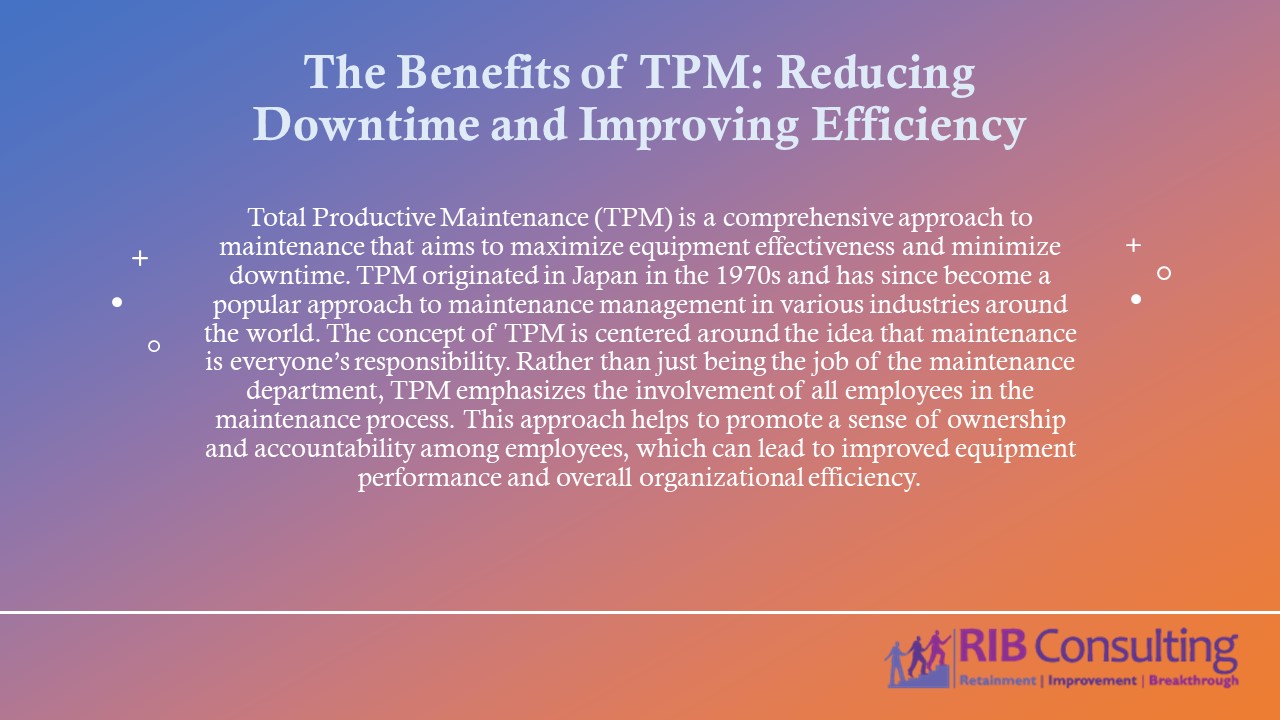The Benefits of TPM: Reducing Downtime and Improving Efficiency
Title:
The Benefits of TPM: Reducing Downtime and Improving Efficiency
Description:
Total Productive Maintenance (TPM) is a comprehensive approach to maintenance that aims to maximize equipment effectiveness and minimize downtime. TPM originated in Japan in the 1970s and has since become a popular approach to maintenance management in various industries around the world. For more info visit : –
Number of Views:13
Title: The Benefits of TPM: Reducing Downtime and Improving Efficiency
1
The Benefits of TPM Reducing Downtime and
Improving Efficiency
- Total Productive Maintenance (TPM) is a
comprehensive approach to maintenance that aims
to maximize equipment effectiveness and minimize
downtime. TPM originated in Japan in the 1970s
and has since become a popular approach to
maintenance management in various industries
around the world. The concept of TPM is centered
around the idea that maintenance is everyones
responsibility. Rather than just being the job of
the maintenance department, TPM emphasizes the
involvement of all employees in the maintenance
process. This approach helps to promote a sense
of ownership and accountability among employees,
which can lead to improved equipment performance
and overall organizational efficiency.
2
- TPM is built on three primary principles
maximizing equipment effectiveness, employee
involvement, and continuous improvement. These
principles are achieved through a series of
activities that are designed to prevent equipment
failures, reduce downtime, and improve equipment
performance. - One of the key activities in TPM is autonomous
maintenance, which involves training operators to
perform routine maintenance tasks, such as
cleaning and lubrication. By involving operators
in the maintenance process, TPM aims to reduce
the workload of the maintenance department,
freeing up their time to focus on more complex
maintenance tasks.
3
- Another important activity in TPM is planned
maintenance, which involves scheduling
maintenance activities in advance based on
equipment performance data. This approach helps
to prevent equipment failures and reduces the
likelihood of unplanned downtime. In addition to
these activities, TPM also emphasizes the
importance of continuous improvement. This
involves identifying areas for improvement in the
maintenance process and implementing changes to
address these issues. By continually improving
the maintenance process, TPM aims to optimize
equipment performance and minimize downtime.
4
- Implementing TPM requires a significant
commitment from an organization. It involves a
cultural shift towards a more collaborative and
proactive approach to maintenance. However, the
benefits of TPM can be significant, including
improved equipment performance, reduced downtime,
and increased productivity. - One potential challenge in implementing TPM is
resistance to change. Employees may be hesitant
to take on new responsibilities or may not see
the value in the approach. To overcome this, its
important to provide training and education on
the benefits of TPM and involve employees in the
implementation process. - Another challenge is the need for accurate data
collection and analysis. TPM relies heavily on
performance data to schedule maintenance
activities and identify areas for improvement.
Without accurate data, it can be difficult to
make informed decisions and achieve the full
benefits of TPM.
5
Thank you
- Website www.ribcon.com
- Email contact_at_ribcon.com
- Mobile No 8588850979

